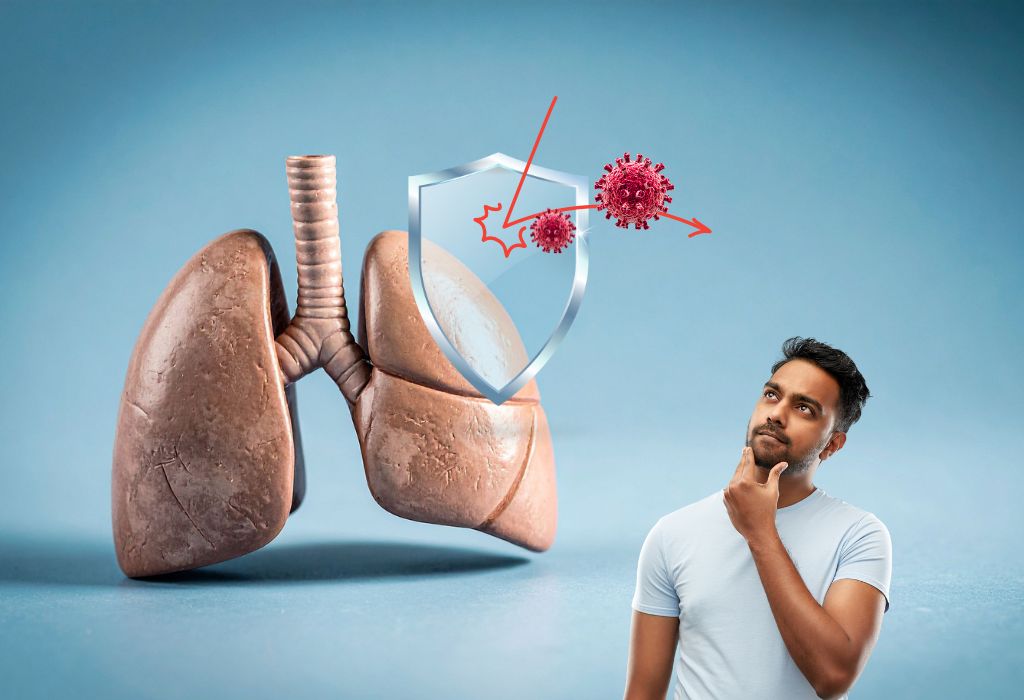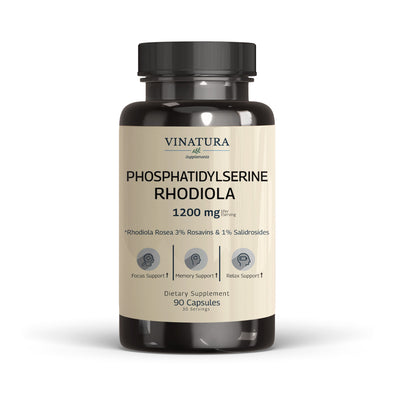
How to Improve Lung Health Naturally
Lung health plays a major role in overall quality of life, as the lungs supply oxygen for all vital activities and influence metabolic processes.
To support lung health, it is important to maintain healthy daily habits, stay physically active, eat a nutrient-rich diet, and minimize exposure to air pollutants in your living environment. In this article, we will explore how to naturally improve lung health from a science-based perspective.
Before exploring further, please read the disclaimer located at the end of this webpage.
Key Takeaways
- Stay physically active on a regular basis to support respiratory function.
- Eat a balanced diet, including foods rich in antioxidants (fruits, leafy greens, omega-3–rich fish) and drink enough water to protect lung health.
- If you smoke, quit completely — this is the most important step to support lung recovery and lower the risk of COPD and lung cancer.
- Keep vaccinations up to date and have annual health check-ups to lower the risk of lung infections and detect respiratory issues early.
- Practice good personal hygiene (wash hands frequently, cover your mouth when coughing, avoid contact with sick individuals) to reduce illness.
- Consider lung cancer screening if you belong to a high-risk group (long-term heavy smokers) according to medical recommendations.
How to Improve Lung Health
What is good for lung health? It’s a common question, but the answer is quite straightforward. Simple, low-cost, and effective practices can help, such as the following:
Maintain Physical Activity

One of the most effective ways to improve lung health is through regular exercise. Physical activity raises heart rate and breathing rate, strengthens the diaphragm and chest muscles, and helps improve lung capacity and gas exchange efficiency.
Even for individuals with chronic respiratory conditions, consistent activity (such as walking, cycling, swimming) can improve endurance and reduce shortness of breath.
For example, one analysis in children showed that adolescents who exercised regularly had significantly better respiratory function parameters including lung capacity, volume, and expiratory flow compared with those who were sedentary (Balbinot et al. 2023) [1].
Moreover, adopting a more active lifestyle helps maintain respiratory strength with age. General recommendations for adults are at least 150 minutes of moderate-intensity physical activity per week (such as brisk walking, light jogging) or 75 minutes of vigorous activity (running, HIIT), combined with muscle-strengthening exercises (Balbinot et al. 2022).
In short, staying physically active allows your lungs to work more efficiently and with greater endurance — a practical step that anyone can start implementing today.
Eat Healthy And Drink Enough Water
Along with exercise, a balanced and nutrient-rich diet is essential for healthy lungs. Some of the best things for lung health include colorful fruits and vegetables, as well as foods high in vitamin C, vitamin E, and antioxidants, which help protect lung cells from free-radical damage.
For instance, a well-known study from Johns Hopkins found that people who ate more tomatoes (a source of lycopene) and fresh fruits (especially apples) every day experienced a significantly slower decline in lung function over time [3].
This is because nutrients in tomatoes and fruits may help repair lung damage caused by smoking and slow the “aging” process of the lungs, even in those who have never smoked [3].
Additionally, omega-3 fatty acids from salmon, mackerel, and flaxseeds have anti-inflammatory properties.
Recent research from the United States indicates that higher blood levels of omega-3 are linked to a slower rate of lung function decline [4]. Therefore, including omega-3–rich and antioxidant-rich foods may help keep your lungs functioning steadily.
Furthermore, according to the American Lung Association, drinking enough water helps keep the mucus in the lungs thin and easier to clear when coughing. Pulmonary specialists recommend drinking at least 1.5–2 liters of water daily to support respiratory health [5].
In addition to water, you can also consume soups and natural juices with high water content. In short, a diet rich in vegetables, fresh fruits, fish, and adequate water intake nourishes the lungs and keeps them performing at their best.
Breathing Exercises

One of the lesser-known ways to strengthen respiratory lung health is through breathing exercises. Deep breathing, diaphragmatic breathing, or paced breathing techniques can improve your lung’s capacity to take in air.
When practicing diaphragmatic breathing (also called belly breathing), you focus on fully engaging and contracting the diaphragm, allowing the lungs to expand more deeply.
On Quora, in response to the question “What are some of the best breathing exercises?”, many techniques have been suggested, including 4-2-4 breathing (inhale for 4 seconds, hold for 2 seconds, exhale for 4 seconds), 4-4-6, 4-7-8, etc., each with different purposes such as relaxation, stress relief, improving focus, and reducing anxiety.*
Studies also support this practice, showing that diaphragmatic breathing improves lung capacity and endurance in individuals with COPD — chronic obstructive pulmonary disease.
Spending just a few minutes a day on breathing exercises can create a powerful, health-boosting habit for your lungs (Hamasaki, et al. 2020) [6].
Quit Smoking
If you smoke, quitting is the single most important step you can take to start restoring your lung health. Cigarettes contain thousands of toxic chemicals that damage lung cells, reduce lung capacity, and harm people exposed to secondhand smoke.
According to the CDC (U.S.), nicotine and other chemicals in tobacco products severely damage the respiratory system and are linked to many consequences: 8 out of 10 COPD-related deaths are caused by smoking, smoking worsens asthma, and it reduces lung function overall.
The CDC also highlights that quitting provides immediate benefits: within 20 minutes after the last cigarette, blood pressure begins to drop; within 2 weeks, lung function improves; within 1 year, the risk of heart-related death drops by almost half compared to continuing to smoke.
The agency states, “Smoking cessation is one of the most important actions people who smoke can take to improve their health and reduce their risk for COPD... This is true for all people who smoke.”
Therefore, if you smoke, quitting is the first and most crucial step to protecting your lungs. Those who quit should also combine this with the other strategies mentioned to maximize lung recovery.
Maintain Good Posture

Another often-overlooked way to support lung health is by maintaining good posture while sitting and standing, since body posture directly affects how well the lungs can expand. Sitting or standing hunched for long periods compresses the diaphragm and chest, reducing the space available for the lungs to expand.
By contrast, standing upright with shoulders open and head lifted helps maximize lung capacity. In one Japanese experiment, lung capacity while sitting with the head bent forward (as in smartphone use) was significantly lower compared to sitting upright (Kang et al. 2016) [7].
Therefore, sitting upright, avoiding slouching, and not bending your head forward for too long allows optimal lung expansion and easier deep breathing. When working or driving for long hours, take short breaks every hour to stand and stretch your spine.
When lying down, use a pillow that does not overly compress the chest and keep your back aligned. These small adjustments help the lungs fully expand during inhalation, improve gas exchange, and reduce shortness of breath caused by chest muscle tightness from prolonged poor posture.
Get Vaccinated & Annual Check-Ups
Vaccinations against respiratory illnesses and regular health check-ups are proactive measures to protect the lungs. Annual flu shots and pneumococcal vaccines help lower the risk of severe lung infections. In addition, COVID-19 vaccination, Tdap (whooping cough) booster, and Hib pneumonia vaccine all contribute to reducing respiratory infection burden.
For those who smoke or frequently experience respiratory problems, routine medical visits and lung function tests are highly valuable for detecting lung damage early and taking timely action.
Seeing a doctor also allows you to monitor indicators such as blood pressure, oxygen saturation, and lung performance, so you can adjust lifestyle habits promptly if needed. In short, staying current with vaccinations and having annual health check-ups are effective ways to manage serious conditions that affect lung health.
Avoid Air Pollution & Improve Indoor Air Quality

Air pollution is a major threat to lung health. Fine particulate matter (PM2.5, PM10), toxic gases, vehicle exhaust, and industrial emissions can trigger chronic inflammation in the airways.
The World Health Organization (WHO) states that inhaling fine particles “can lead to reduced lung function, respiratory infections and aggravated asthma from short-term exposure.”
People living in crowded neighborhoods or industrial areas may experience irritation, difficulty breathing, or chronic cough when exposed to polluted air frequently.
Over time, fine particle pollution raises the risk of COPD, asthma, and even lung cancer. Therefore, one of the most effective protective measures is limiting outdoor exposure when air quality is poor.
Indoors, ensure proper ventilation (open windows, use kitchen exhaust fans) and consider an air purifier if you live in a polluted region. Avoid smoking indoors and minimize the use of gas stoves without ventilation. Growing indoor plants that can absorb certain pollutants may also slightly improve indoor air quality.
When going outside, wearing a medical mask or an N95 mask helps reduce inhalation of harmful pollutants and protects your lungs.
Practice Good Hygiene
Maintaining good personal hygiene helps limit bacteria and viruses from entering the respiratory tract and harming the lungs. Respiratory infections (cold, flu, pneumonia, COVID-19) are common causes of temporary or long-term lung function decline.
To lower the risk of infection, wash your hands frequently (after coughing/sneezing, using the restroom, before meals) to remove pathogens. Avoid close contact with individuals who have fever or cough, and wear a mask in crowded places if necessary.
Clean surfaces and door handles regularly to reduce germ spread. When sick, cover your mouth when coughing and use tissues to avoid spreading droplets into the air. These simple steps reduce the “attacks” of viruses and bacteria that can compromise lung health.
Lung Cancer Screening (For High-Risk)
Finally, for those at high risk, especially older adults with a long history of smoking, lung cancer screening can be life-saving if the disease is detected early.
Early-stage lung cancer usually does not cause obvious symptoms, but low-dose CT scans performed regularly can significantly improve the chances of successful intervention. U.S. medical guidelines (USPSTF) recommend annual low-dose CT screening for individuals aged 50–80 with a smoking history of ≥20 pack-years [8].
Screening does not limit lung cancer but can detect it early, allowing timely treatment plans. In this case, early action is better than waiting until symptoms appear, so staying proactive is key to protecting your health.
Conclusion
Strong lung health is built from multiple pillars: regular physical activity, balanced nutrition, proper breathing practices, and healthy lifestyle habits. Each of the strategies above is backed by scientific evidence and can be combined for the best results.
For those who smoke, quitting and getting screened for lung cancer are the top priorities. Take action today: exercise regularly, eat a well-balanced diet, avoid smoke and pollution and protect your health for the long term.
Testimonial Disclaimer
*The testimonials presented on this website are provided by individuals based on their personal experiences with our products. These testimonials represent individual opinions and experiences, which may not be typical or applicable to all users of our products. Results may vary depending on a variety of factors, including individual health, lifestyle, and adherence to product usage instructions.References
- [1] Balbinot, Fernanda, et al. “Does Regular Exercise Impact the Lung Function of Healthy Children and Adolescents? A Systematic Review and Meta-Analysis.” Pediatric Exercise Science, vol. 35, no. 3, Human Kinetics, Aug. 2023, pp. 186–94, https://doi.org/10.1123/pes.2022-0045.
- [3] “Diet Rich in Apples and Tomatoes May Help Repair Lungs of Ex-Smokers, Study Suggests | Johns Hopkins Bloomberg School of Public Health.” Johns Hopkins Bloomberg School of Public Health, 21 Dec. 2017, publichealth.jhu.edu/2017/diet-rich-in-apples-and-tomatoes-may-help-repair-lungs-of-ex-smokers-study-suggests
- [4] “Omega-3 Fatty Acids Appear Promising for Maintaining Lung Health.” NHLBI, NIH, 20 July 2023, www.nhlbi.nih.gov/news/2023/omega-3-fatty-acids-appear-promising-maintaining-lung-health-0
- [5] American Lung Association. “Understanding Mucus in Your Lungs.” Lung.org, 2021, www.lung.org/blog/lungs-mucus
- [6] Hamasaki, Hidetaka. “Effects of Diaphragmatic Breathing on Health: A Narrative Review.” Medicines, vol. 7, no. 10, Multidisciplinary Digital Publishing Institute, Oct. 2020, pp. 65–65, https://doi.org/10.3390/medicines7100065. Accessed 24 Sept. 2025.
- [7] Kang, Kyung Woo, et al. “Effect of Sitting Posture on Respiratory Function While Using a Smartphone.” Journal of Physical Therapy Science, vol. 28, no. 5, Penerbit Universiti Sains Malaysia, Jan. 2016, pp. 1496–98, https://doi.org/10.1589/jpts.28.1496.
- [8] “Recommendation: Lung Cancer: Screening | United States Preventive Services Taskforce.” Uspreventiveservicestaskforce.org, 2021, www.uspreventiveservicestaskforce.org/uspstf/recommendation/lung-cancer-screening
Author

Product Disclaimer
Including an ingredient or study does not evaluate, endorse, or recommend any Vinatura product or any third-party product. Some ingredients discussed may not be used in any Vinatura product.
The content of the articles has not been evaluated by the Food and Drug Administration (FDA) and is not intended to promote or endorse any specific product. Any products sold on this website are not intended to diagnose, treat, cure, or prevent any disease.
Opinions and Endorsements
Any claims, statements, or opinions expressed in the articles are those of the author(s) and do not necessarily reflect the views or opinions of the manufacturers of the dietary supplement products. The products sold on this website are separate from the content of the articles and are not directly endorsed or associated with the information presented here.
Liability Disclaimer
The author(s) of the articles, website, and manufacturers of the dietary supplement products do not assume any liability for any potential consequences arising from the use of the information provided in the articles. Ingredient effects, dosages, and safety vary by individual, formulation, and context; some ingredients interact with medications or may be unsuitable during pregnancy or lactation. It is recommended that individuals consult with a qualified healthcare professional before making any dietary or lifestyle changes, including the use of dietary supplements.
Product Usage
Please refer to the product labels and packaging for specific usage instructions and guidelines for the dietary supplement products sold on this website.
Customer Support
For any concerns or questions regarding the dietary supplement products, please contact our customer support team, who will be more than happy to assist you.





Leave a Comment
Be the first to comment.
What do you think?